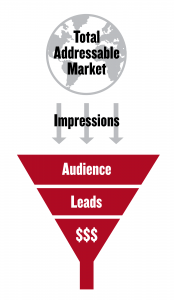
One of the most common and difficult tasks given to PR professionals is to prove the worth of their discipline. In many cases, stakeholders and executives will ask if PR can be tied to sales. To answer this question, we must first under- stand what the roles of media, marketing and sales are. Once these roles are clearly defined, we can determine how best to view PR’s role in generating revenue and creating tangible business impacts.
The function of media, whether generated by advertising or public relations (paid or earned), is to create awareness and trust for a brand.
As people are exposed to a brand in traditional and digital media, their knowledge of the brand should grow.
Thus, we must measure the effectiveness of PR and advertising by the audiences they create or help us gain access to.
THE PROCESS
The function of marketing is to identify and extract qualified potential customers in the new audiences into leads, people who are likely to buy.
It’s important to understand that the process of identifying leads occurs in all forms of marketing, be it B2B, B2C, enterprise or small business.
A three-year-old child pointing frantically at a bag of candy at the supermarket checkout line is no less likely a potential buyer (or influencer of a buyer) than a corporate executive considering a $95 million jet purchase.
The function of sales is to convert those leads, those potential buyers, into customers and revenue. Sometimes sales is a human being “smiling and dialing,” and other times it’s a customer using a self-service checkout lane in a store, but the net effect is the same: a customer relationship is formed and revenue is generated.
In order to tie PR to sales, we need to understand the processes by which PR’s outcome (audiences) becomes part of the sales process.
These three functions exist in businesses of every size and type, from enterprise B2B sales to the smallest B2C kid’s lemonade stand.
Businesses run into trouble when they measure using the wrong metrics. Businesses have more tools at their disposal to track the performance of paid, earned and owned media than ever before, from Web analytics to affordable CRM systems and more.
However, these systems are only as good as the data they collect.
In order to understand and correctly attribute the performance of advertising or any form of marketing, we first must understand what we are measuring.
The function of PR and earned media isn’t to make an immediate sale, just as the function of a sales clerk isn’t primarily to do public relations. We wouldn’t measure a salesperson’s performance on new audiences. We’d measure them on how much they sold. Likewise, we wouldn’t and shouldn’t measure advertising on its ability to generate sales.
THE MARKETING FUNNEL

We need to measure advertising and PR on their ability to generate audiences. We need to measure marketing on its ability to generate leads. We need to measure sales on its ability to create revenue and customers.
In order to effectively tie PR to sales, we have to measure each stage of the marketing funnel, from the bottom up.
Let’s look at a basic example of how this might work from the perspective of a kid’s lemonade stand, the simplest business model possible. Let’s make it a really upscale one, where a glass of lemonade costs $10—it’s a really good glass of lemonade, made with hand-refined turbinado sugar cane and sustainable, organic, non- GMO lemons.
Let’s say our lemonade stand sells a glass of lemonade to 50% of prospective customers who approach it because we hire adorable kids.
Thus, a sale is worth $10, and a prospective customer who walks up to the lemonade stand is worth $5 because of the 50% closing rate.
If I wanted to make $50, I’d need to get 10 people to walk by the lemonade stand so that 5 of them would buy a glass.
So far, so good. Now let’s say our little lemonade stand starts to do well but needs more people to come by. We invite reporters and prominent community members to stop by the lemonade stand.
A few folks do, and they publish some nice articles on the Web about our lemonade stand.
Of the people who see that piece, 10% of them decide to stop by. Let’s say that 1,000 people read the published piece. That means 100 of them will stop by. We know that our adorable kids will get 50 of them to buy a glass of lemonade, and that means we’ll generate $500 in revenue.
Thus, if we work backwards, it takes 1,000 people to generate $500 of revenue, which means that every audience member who read the articles about us is effectively worth $0.50. If we want our lemonade stand to generate $1,000 in revenue, we have to double our audience-building efforts to reach 2,000 people by the math in this simple example.
That’s the method by which we can make successful valuations of PR’s output and tie it to concrete, tangible sales metrics without asking PR professionals to do the job of sales professionals and vice versa.
PR creates the audiences that a salesperson eventually sells to, and we evaluate the value of those audiences as PR’s contribution to sales.
The catch with this particular methodology is that the quality of the audience matters. Targeting and reaching out to moms interested in products for their children for corporate jet sales is going to produce a poor outcome.
FOCUS ON OUPUT
Even if the moms are conceptually interested in a corporate jet, most of them are unlikely to purchase one.
To ensure that PR and advertising are obtaining the correct audiences, the calculations performed above must be recalculated on a very frequent basis, such as a rolling 30- or 90-day window.
The indicator that PR may not be performing to its peak output is told in the conversion rate between audience member and lead.
In the end, if PR is doing its job, new, highly engaged audiences will be created. A portion of those audience members will be ready to consider purchasing. Some percentage of those leads will convert to sales, generate revenue and showcase the value of the audiences that PR creates.
Measure for Measure

One of the best tools for measuring audience is your Web analytics, such as Google Analytics. Inside these very common tools you can measure all of the basics you need in order to determine the impact of PR.
Here are three important metrics to pay attention to inside your Web analytics software.
1. New visitors. New visitors is the number of people who have never visited your website before and are stopping by for the first time. While a lot of things can contribute to new visitors, it’s an important first place to look. If new visitors aren’t increasing, then ultimately your website is in trouble. When you get great hits, you can often see spikes in your website’s new visitors.
Obviously, unique new visitors can come from many different sources, including organic search, paid advertising and public relations. However, if your unique new visitors rate isn’t growing, you know you’ve got to step up your PR game to get more awareness for your brand.
2. Returning visitors. Think only new visitors are important? Think again. It’s rare that a sale/conversion will be made on the first visit. More often than not, you have to build trust with your audience, a core function of public relations work. The more earned media you get, the more trust your audience should develop in your brand.
This is also why content marketing is so popular with PR and marketing professionals. If you create content, you’re creating a gift of valuable information for your visitors to read/share. It’s a signal to your audiences that if they return it is likely to find something of interest to assist them in making a decision or solving a problem.
Returning visitors is a proxy for trust that you’ll keep that promise. It’s actually more important than new visitors—if you don’t keep the visitors you have, you’ll forever be spending more and more money and time to replace them. Awareness creates the relationship, but trust strengthens it.
3. Referrals. Web analytics referrals are the bread and butter of public relations work. They tell you where your website is getting its traffic from. Referrals showcase your work in earned media placements with links in them. Popular articles and placements drive traffic to the website.
If you’re not getting media placements with links to click through, change your PR pitching processes to include those links. Not only will the brand get a side SEO benefit but also you’ll be sending new audiences directly to the brand, which will drive growth, leads and revenue.
(This article was written by Christopher Penn, VP of marketing technology at SHIFT Communications. It is an excerpt from PR News’ Measurement Guidebook, Vol. 8. To order a copy, please go to https://www.prnewsonline.com//prpress/.)
CONTACT:
Christopher Penn, [email protected].
This article originally appeared in the August 4, 2014 issue of PR News. Read more subscriber-only content by becoming a PR News subscriber today.
